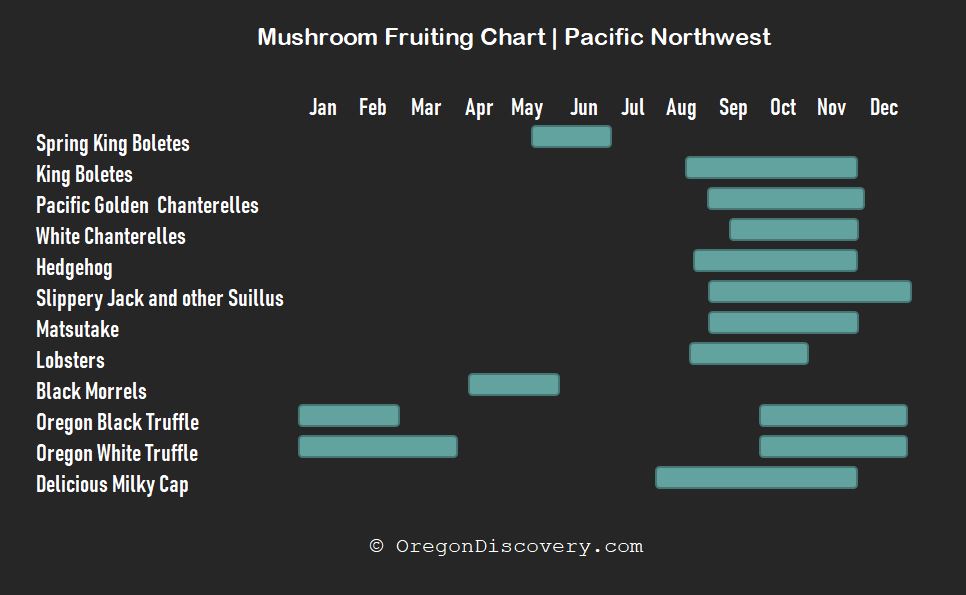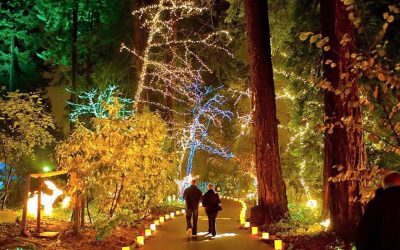Oregon has the perfect environment to nurture dozens of species of edible wild mushroom varieties. Whats more, fall is the perfect season to go off on a foraging expedition of your own!
Before you begin, take a moment to learn some very important details that will make your collecting experience enjoyable and risk-free. The best advice you can get while edible mushroom foraging is to approach with absolute caution. There are many wild species in Oregon alone. This means it can be easy to confuse edible with poisonous ones.

Eating Amanita.
The golden rule of thumb for mushroom collecting is to avoid anything suspicious and to have an expert on hand to confirm that your basket isn’t full of a deadly look-alike. It is ALWAYS wise to use a few field guides to cross-reference. We can't stress this enough! A great one to start with is All That the Rain Promises and More: A Hip Pocket Guide to Western Mushrooms by David Arora.
With disclaimers and caution in mind, where can you find these edible delicacies? Rule number one: KNOW YOUR TREES

That Oregon Life / Danielle Denham / thePDXphotographer
Different mushrooms grow under certain types of trees and prefer a specific climate and soil. Finding the right forest that is suitable for particular species of the fungi is key to a successful search and proper identification.
Douglas-fir supports boletes and chanterelles.
Pine is associated with boletes including King boletes, hedgehog mushroom, matsutake, chanterelles, slippery jack, and other suillus.
Under Oak, you can find boletes, chanterelles, blewits, black trumpets, honey mushrooms, and oysters.
Western hemlock host of a number of fungi such as boletes, matsutake, chanterelles.
Sitka spruce is associated with boletes and slippery jack.
Aspen is a common host for oyster mushroom, honey mushrooms, and aspen boletes.
Willow is associated with oyster and honey mushrooms.
Birch supports chanterelles, hedgehogs, and boletes.
Where and When To Hunt for Your Fungi
As one forager put things: "In the heart of the largest temperate rainforest in the world, Douglas firs, cedars, and other evergreens, along with alder and bigleaf maple, support a lush, diverse ecosystem. Rich duff — the needles, leaves, and cones that fall from trees and decay into rich humus on the forest floor — creates an indescribable, earthy smell and provides sustenance to a variety of wildlife. Just under your feet, decay feeds regeneration. When you reach down and feel and smell this earth in search of mushrooms, you’re encountering the stuff of life itself."
Mushroom hunting is an immersive experience.
Great places to start are damp Coastal areas such as the Tillamook State Forest and the Siuslaw State Forest. The Cascade Range is a fantastic place to look as well, but keep in mind that some have certain collection regulations in place. For instance, the Mt. Hood National Forest has easy to follow guidelines.

Mushroom Grow Chart / oregondiscovery.com
What Species Can You Find?
Chanterelle

Yellow Chanterelle Mushrooms
The Pacific Golden Chanterelle is the official Oregon State Mushroom. This variety is very hard to cultivate outside of the wild, and is prized all over the world for it's sweet apricot aroma, meaty texture, and richly nutty flavor.
Morel

Morel Mushrooms

A Morel mushroom in the wild.
Morels are spongy, have a conical appearance, and are completely hollow inside. They are famous for their flavor which is nutty, meaty, earthy, and utterly unique. Compliment these guys with a sauté in butter.
Matsutake

Matsutake Mushrooms
Many people have a love/hate relationship with these highly-prized fungi that are described as spicy and intense (although others may say foul or pungent!). In Japan Matsutakes are given as important gifts, meant to symbolize fertility and happiness.
Bolete or Porcini

Bolete Mushrooms

King Bolete Mushroom cross-section / oregondiscovery.com
The Bolete is a very popular, delicious, meaty mushroom that grows all over the world. Known as a Porcini in Italy, They are great for drying, pickling, freezing, frying, and sautéing. Just be sure to cook them well.
Cauliflower Mushroom

Cauliflower Mushroom
Cauliflower mushrooms are the ultimate soup mushroom, kind of like an al dente egg noodle. It has a mild flavor a lot like a morel that pairs very well with red meats. However, these guys only grow in specific regions and are difficult to find. Prepare to be astounded if you do...I've heard of some growing up to 16 lbs. in weight!
Lobster Mushroom

Lobster Mushrooms

Lobster Mushroom in the wild
Lobster mushrooms actually aren't a fungi at all, but a parasitic mold (are you hungry yet??). They have a firm and meaty dense texture with a nutty, sweet smell reminiscent of steamed lobster! Sliced up, these beauties do look a lot like chunks of crustacean meat.
Chicken of the Woods

Chicken of the Woods Mushroom growing wild.

Chicken-fried Chicken of the Woods / Alan Bergo / foragerchef.com
This mushroom is a type of bracket-fungus that some people describe as having a flavor and texture just like chicken. It can be used as a nutritious meat substitute for vegetarian dishes.
Truffles

Oregon White Truffles / Faith Cathcart / The Oregonian / oregonlive.com

Oregon Black Truffles
Probably one of the most famous (Nicholas Cage is making a movie about them!) and expensive fungi in Oregon, truffles can be found in black and white varieties. Depending on the demand, these can fetch prices in excess of $300 a pound...if you know where to look. Pigs have been used in France for centuries, but your family Fido can be trained to sniff out these little goldmines as well. Truffles grow at the base of Douglas Fir trees, buried in dirt and pine needles.
Gourmets call their scent intoxicating. Their flavor is indescribably musky, reminiscent of garlic and cheese. And Oregon-native Burgerville serves up some damn good truffle fries.
These are just a few examples of delicious wild fungi in the Pacific Northwest.
I've got my 'Shrooms. Now what?
Use these culinary delights to whip up something magical!

Hungarian Mushroom Soup with Wild Chanterelles and Fresh Dill / Platings+Pairings / Recipe Here

Mushroom cream Ravioli

Wood-fired Pizza with Mushrooms

Mushroom BBQ Skewers
Note: Mushroom hunting, and eating wild foraged mushrooms is an at-your-own-risk activity.
Happy and safe foraging!













